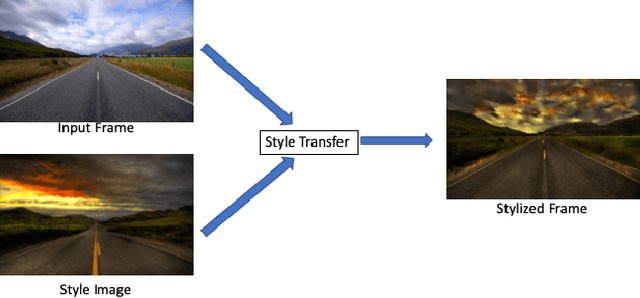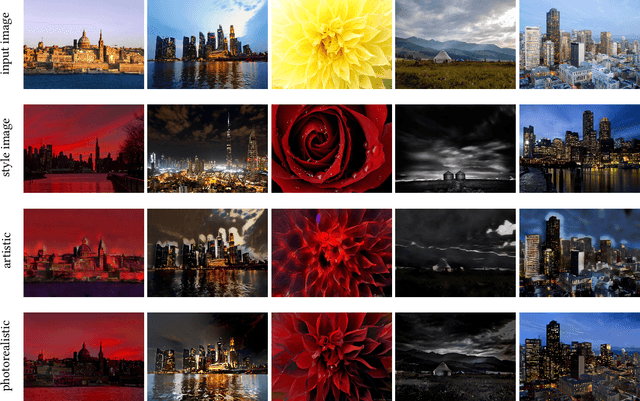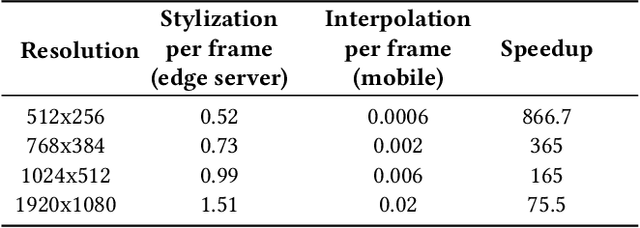Bin Ni
MVStylizer: An Efficient Edge-Assisted Video Photorealistic Style Transfer System for Mobile Phones
Jun 01, 2020



Abstract:Recent research has made great progress in realizing neural style transfer of images, which denotes transforming an image to a desired style. Many users start to use their mobile phones to record their daily life, and then edit and share the captured images and videos with other users. However, directly applying existing style transfer approaches on videos, i.e., transferring the style of a video frame by frame, requires an extremely large amount of computation resources. It is still technically unaffordable to perform style transfer of videos on mobile phones. To address this challenge, we propose MVStylizer, an efficient edge-assisted photorealistic video style transfer system for mobile phones. Instead of performing stylization frame by frame, only key frames in the original video are processed by a pre-trained deep neural network (DNN) on edge servers, while the rest of stylized intermediate frames are generated by our designed optical-flow-based frame interpolation algorithm on mobile phones. A meta-smoothing module is also proposed to simultaneously upscale a stylized frame to arbitrary resolution and remove style transfer related distortions in these upscaled frames. In addition, for the sake of continuously enhancing the performance of the DNN model on the edge server, we adopt a federated learning scheme to keep retraining each DNN model on the edge server with collected data from mobile clients and syncing with a global DNN model on the cloud server. Such a scheme effectively leverages the diversity of collected data from various mobile clients and efficiently improves the system performance. Our experiments demonstrate that MVStylizer can generate stylized videos with an even better visual quality compared to the state-of-the-art method while achieving 75.5$\times$ speedup for 1920$\times$1080 videos.
BERT-CNN: a Hierarchical Patent Classifier Based on a Pre-Trained Language Model
Nov 03, 2019Abstract:The automatic classification is a process of automatically assigning text documents to predefined categories. An accurate automatic patent classifier is crucial to patent inventors and patent examiners in terms of intellectual property protection, patent management, and patent information retrieval. We present BERT-CNN, a hierarchical patent classifier based on pre-trained language model by training the national patent application documents collected from the State Information Center, China. The experimental results show that BERT-CNN achieves 84.3% accuracy, which is far better than the two compared baseline methods, Convolutional Neural Networks and Recurrent Neural Networks. We didn't apply our model to the third and fourth hierarchical level of the International Patent Classification - "subclass" and "group".The visualization of the Attention Mechanism shows that BERT-CNN obtains new state-of-the-art results in representing vocabularies and semantics. This article demonstrates the practicality and effectiveness of BERT-CNN in the field of automatic patent classification.
Low-dimensional Semantic Space: from Text to Word Embedding
Nov 03, 2019Abstract:This article focuses on the study of Word Embedding, a feature-learning technique in Natural Language Processing that maps words or phrases to low-dimensional vectors. Beginning with the linguistic theories concerning contextual similarities - "Distributional Hypothesis" and "Context of Situation", this article introduces two ways of numerical representation of text: One-hot and Distributed Representation. In addition, this article presents statistical-based Language Models(such as Co-occurrence Matrix and Singular Value Decomposition) as well as Neural Network Language Models (NNLM, such as Continuous Bag-of-Words and Skip-Gram). This article also analyzes how Word Embedding can be applied to the study of word-sense disambiguation and diachronic linguistics.
 Add to Chrome
Add to Chrome Add to Firefox
Add to Firefox Add to Edge
Add to Edge